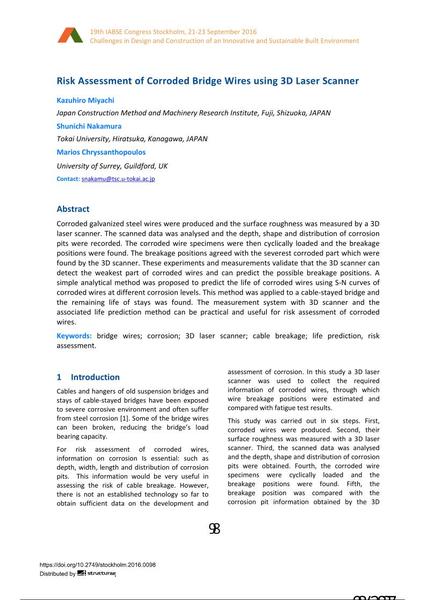Risk Assessment of Corroded Bridge Wires using 3D Laser Scanner

|
|
|||||||||||
Bibliografische Angaben
| Autor(en): |
Kazuhiro Miyachi
(Japan Construction Method and Machinery Research Institute, Fuji, Shizuoka, JAPAN)
Shunichi Nakamura (Tokai University, Hiratsuka, Kanagawa, JAPAN) |
||||
|---|---|---|---|---|---|
| Medium: | Tagungsbeitrag | ||||
| Sprache(n): | Englisch | ||||
| Tagung: | IABSE Congress: Challenges in Design and Construction of an Innovative and Sustainable Built Environment, Stockholm, Sweden, 21-23 September 2016 | ||||
| Veröffentlicht in: | IABSE Congress Stockholm, 2016 | ||||
|
|||||
| Seite(n): | 98-106 | ||||
| Anzahl der Seiten (im PDF): | 9 | ||||
| Jahr: | 2016 | ||||
| DOI: | 10.2749/stockholm.2016.0098 | ||||
| Abstrakt: |
Corroded galvanized steel wires were produced and the surface roughness was measured by a 3D laser scanner. The scanned data was analysed and the depth, shape and distribution of corrosion pits were recorded. The corroded wire specimens were then cyclically loaded and the breakage positions were found. The breakage positions agreed with the severest corroded part which were found by the 3D scanner. These experiments and measurements validate that the 3D scanner can detect the weakest part of corroded wires and can predict the possible breakage positions. A simple analytical method was proposed to predict the life of corroded wires using S-N curves of corroded wires at different corrosion levels. This method was applied to a cable-stayed bridge and the remaining life of stays was found. The measurement system with 3D scanner and the associated life prediction method can be practical and useful for risk assessment of corroded wires. |
||||
| Stichwörter: |
Korrosion Risikobewertung
|
||||

